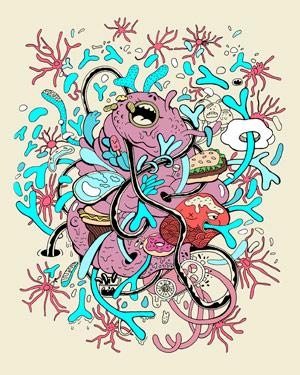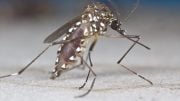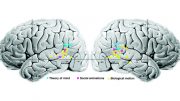
A surrealism-pop interpretation of the intricate metabolic processes involved in appetite and body weight regulation. Credit: Albert Cano
In two newly published studies, researchers show how mitochondria play a key role in the body’s ability to control weight gain.
Becoming obese or remaining lean can depend on the dynamics of the mitochondria, the body’s energy-producing “battery,” according to two new studies by Yale School of Medicine researchers featured as the cover story in the September 26 issue of the journal Cell.
Mitochondria are vital cellular organelles that generate and maintain proper energy levels in complex organisms. Using animal models, the Yale research team studied mitochondria in different populations of brain cells known to be involved in the regulation of appetite. The team found that during the transition from fasting to an over-fed state, mitochondria in neurons that promote hunger show dynamic changes that are the opposite of those found in neurons that control feelings of fullness.
“We’ve found that mitochondrion needs to have ongoing dynamic plasticity in order to support neurons, which are necessary for appetite and for the maintenance of life,” said lead author Tamas Horvath, the Jean and David W. Wallace Professor of Biomedical Research and chair of comparative medicine at Yale School of Medicine. “If these dynamic events — during which the mitochondria fuse to become more effective in generating energy — are disrupted, mitochondria become static, appetite-stimulating neurons become less active, and animals do not develop obesity when exposed to high-fat, high-calorie diets.”
Yale co-lead author Dr. Marcelo de Oliveira Dietrich said these same cellular events have different consequences in neurons that promote feelings of fullness. These consequences were described in a separate paper in the same issue of Cell, co-authored by Dietrich, Horvath, and a research team in Spain.
The study showed that similar molecular drivers control mitochondria-endoplasmic reticulum interactions and related stress. If the cellular events are disrupted in these mitochondria, animals become morbidly obese.
“The generally accepted view has been that once a cellular biological principle is established in a model system, that principle would hold for most cells of the body. That is clearly not the case here,” said Horvath, who points out some practical considerations from the results.
“For example, the mitochondria have been implicated in the development of chronic diseases such as diabetes, cancer, and neurodegeneration, and targeting mitochondria is an emerging therapeutic approach,” he notes. “Our results raise doubt about the rationale of systematically targeting any specific mitochondrial mechanism for the treatment of chronic diseases, because in one cell or tissue, it may result in a very different, potentially undesired outcome than in the other.”
Zhong-Wu Liu of Yale was a co-author of the study.
The study was funded by the National Institutes of Health (DP1DK006850, RO1AG040236, and PO1NS062686), the American Diabetes Association, The Helmholtz Society, and the Conselho Nacional de Desenvolvimento Cientifico e Tecnologico.
References:
“Mitochondrial Dynamics Controlled by Mitofusins Regulate Agrp Neuronal Activity and Diet-Induced Obesity” by Marcelo O. Dietrich, Zhong-Wu Liu and Tamas L. Horvath, 26 September 2013, Cell.
DOI: 10.1016/j.cell.2013.09.004
“Mitofusin 2 in POMC Neurons Connects ER Stress with Leptin Resistance and Energy Imbalance” by Marc Schneeberger, Marcelo O. Dietrich, David Sebastián, Mónica Imbernón, Carlos Castaño, Ainhoa Garcia, Yaiza Esteban, Alba Gonzalez-Franquesa, Ignacio Castrillón Rodríguez, Analía Bortolozzi, Pablo M. Garcia-Roves, Ramon Gomis, Ruben Nogueiras, Tamas L. Horvath, Antonio Zorzano and Marc Claret, 26 September 2013, Cell.
DOI: 10.1016/j.cell.2013.09.003









This demonstrates R Sheldrake’s belief that genetic engineering will not be successful. It is analogous to the statement: Genetic engineering is opening one door and finding 12 new doors.
In my family my father was a sweet addict and so am I and one sister. Whereas my children are not sweet addicts and so are my another brother and another sister. I have seen the reasons for this sweet addiction, when I don’t get satisfied signals from my brain with just one sweet. Whereas my children immediately stop taking more than one sweet since they get satisfying signals from their brain immediately. Naturally consuming more sweets or ‘carbs’ without doing any exercise will add to obesity. Restricting the food with correct signals from the brain can make one fit and lean in spite of not doing any exercise. The demand supply chain is regulated by the brain neurons which produce both “Dopamine” for instigating action and “Serotonin” for checking the result. In my case of sweet addiction “Dopamine” acts fast for craving to take the sweets and “Serotonin” ,the feel good harmone is produced late to do havoc. Even the “reuptake” of Serotonin is fast and thus satisfaction remaining only for shorter duration. I have to take “Serotonin reuptake inhibitors” to check the cycle. This is true even in case of other cortico-steroids like Adrenaline which makes one lose temper easily. This may result in Hypertension and Diabetes. The entire drama is enacted by ‘Mitochondria’ of brain neurons which should be taught properly through medications. Mitochondria of the other cells of the body are confined to their dedicated task of running the human engine by powering. This article is an eye opener for pin pointing the primary causes of Obesity, Hypertension , Diabetes etc. After all Mitochondria of brain neurons power the production of regulators called Harmones through pineal and pituitory glands and also other Ductless glans of Human machine like Supra renal , Gonads ,Thyroid etc .In animals they don’t have plenty of food and so their Mitochondria is disciplined to take food only to the extent it is needed for their activities. Hence it is natural that they are not obese mostly except the domestic animals like dog which are exploited. Thank You.
liver converts the neutitions especialy to energy sources and excess carbohydrates were converted to fat. This fat turns back into energy by Mitochondria in the cell, using oxygen available within the cell. Mitochondria are very important energy converters. In this process they produce waste products are called reactive oxygen species. thus liberated free radical participates in mutation. these mutations can affect areas of high energy demand such as brain, muscles, central nervous system and the eye. People suffering from Parkinson’s or Alzheimer’s disease are due to these side effects.Once the Mitochondria starts dying in the old age resulting accumulation of fat ( number of Mitochondria avilable gets decreases), the dead mitachondria resulting in free raduicals bringing Alzimier disease. So the new medicines need to propel’s faster new growth of mitachondria’s and stimulates removal of free radicals from the body as soon as forms. According to this obesity grows based on the how many active mitachondria present in the body?